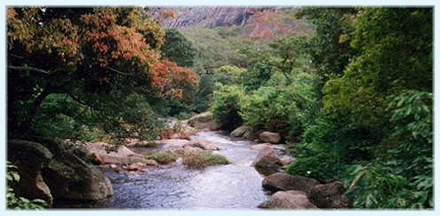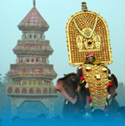Kerala Landscape
Kerala is a long stretch of enchanting greenery in the South West Coast of India. The tall exotic Coconut palm dominates the landscape. The sea, backwaters, lakes and waterfalls - 30% of Kerala landscape is dominated by water.

|
| Đ 2006 Cyril Thomas |
Landscape
Much of Kerala's notable biodiversity is concentrated
and protected in the Agasthyamalai Biosphere Reserve in the eastern
hills. Almost a fourth of India's 10,000 plant species are found
in the state. Among the almost 4,000 flowering plant species (1,272
of which are endemic to Kerala and 159 threatened) are 900 species
of highly sought medicinal plants. Its 9,400 kmē of forests include
tropical wet evergreen and semi-evergreen forests (lower and middle
elevations 3,470 kmē), tropical moist and dry deciduous forests
(mid-elevations 4,100 kmē and 100 kmē, respectively), and montane
subtropical and temperate (shola) forests (highest elevations 100
kmē). Altogether, 24% of Kerala is forested Two of the world's Ramsar
Convention listed wetlands Lake Sasthamkotta and the Vembanad-Kol
wetlands are in Kerala, as well as 1455.4 kmē of the vast Nilgiri
Biosphere Reserve. Subjected to extensive clearing for cultivation
in the 20th century, much of Kerala's forest cover is now protected
from clearfelling. Kerala's fauna are notable for their diversity
and high rates of endemism: 102 species of mammals (56 of which
are endemic), 476 species of birds, 202 species of freshwater fishes,
169 species of reptiles (139 of them endemic), and 89 species of
amphibians (86 endemic). These are threatened by extensive habitat
destruction (including soil erosion, landslides, salinization, and
resource extraction).
Eastern Kerala's windward mountains shelter tropical moist forests
and tropical dry forests, which are common in the Western Ghats.
Here, sonokeling (Indian rosewood), anjili, mullumurikku (Erythrina),
and Cassia number among the more than 1,000 species of trees in
Kerala. Other plants include bamboo, wild black pepper, wild cardamom,
the calamus rattan palm (a type of climbing palm), and aromatic
vetiver grass (Vetiveria zizanioides). Living among them are such
fauna as Asian Elephant, Bengal Tiger, Leopard (Panthera pardus),
Nilgiri Tahr, Common Palm Civet, and Grizzled Giant Squirrel. Reptiles
include the king cobra, viper, python, and crocodile. Kerala's birds
are legion-Peafowl, the Great Hornbill, Indian Grey Hornbill, Indian
Cormorant, and Jungle Myna are several emblematic species. In lakes,
wetlands, and waterways, fish such as kadu (stinging catfish and
Choottachi (Orange chromide Etroplus maculatus; valued as an aquarium
specimen) are found.
This article is licensed under the GNU Free Documentation License. It uses material from the Wikipedia and numerous other sources that provide freedom to copy and redistribute content, with or without modifying it, either commercially or noncommercially. |







